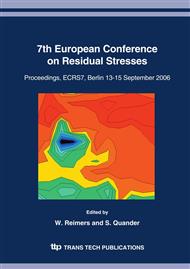p.833
p.841
p.847
p.853
p.859
p.867
p.873
p.879
p.885
Second Order Stresses Distribution in Textured Copper
Abstract:
Internal stresses are an important factor in understanding the work hardening behaviour of polycrystalline materials. The goal of the present paper is to study the development of second order stresses in textured copper sheets at large plastic strains, up to fracture by X-ray diffraction. Second order stresses manifest themselves as peak displacements and width changes as azimuth and tilt angles are varied. As the acquisition is performed with a position sensitive detector, a specific correction of intensities is required in order to take into account texture influence on peak shape and consequently on peak position and width.
Info:
Periodical:
Pages:
859-864
Citation:
Online since:
September 2006
Authors:
Keywords:
Price:
Сopyright:
© 2006 Trans Tech Publications Ltd. All Rights Reserved
Share:
Citation:


